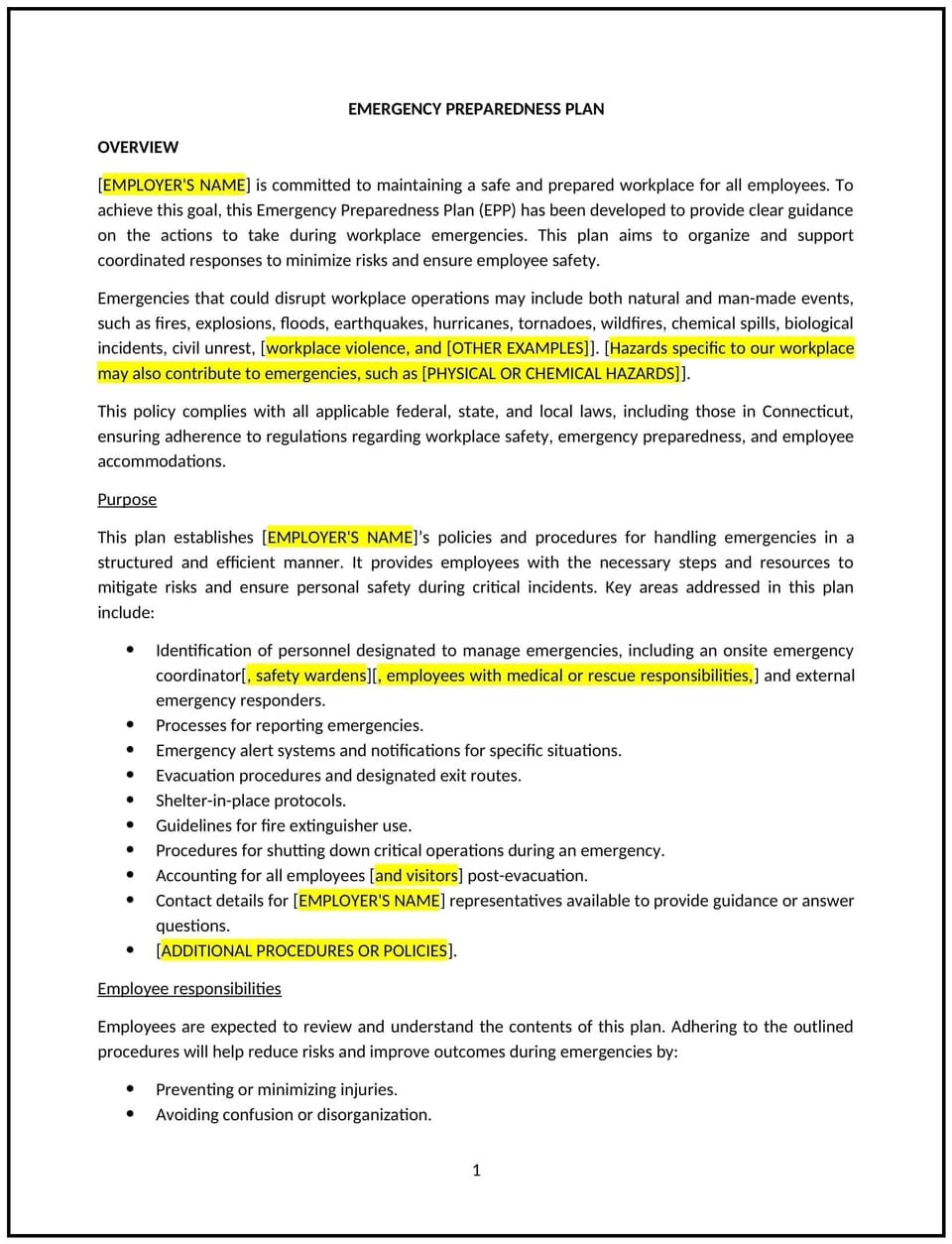Emergency preparedness plan (Connecticut): Free template

Emergency preparedness plan (Connecticut)
An emergency preparedness plan helps Connecticut businesses establish clear procedures for responding to various emergencies, including natural disasters, fires, medical emergencies, or security threats. This policy outlines the steps to take before, during, and after an emergency to protect employees, minimize damage, and ensure business continuity.
By implementing this plan, businesses can ensure a swift and coordinated response to emergencies, reduce risks to employees and assets, and maintain operational resilience.
How to use this emergency preparedness plan (Connecticut)
- Define emergency scenarios: Identify potential emergencies that could impact the business, such as fires, floods, power outages, medical emergencies, or workplace violence.
- Establish roles and responsibilities: Assign specific roles and responsibilities to employees, including who will lead the response, who will communicate with external agencies, and who will ensure employee safety.
- Develop response procedures: Outline clear and actionable steps for each type of emergency, including evacuation routes, emergency contacts, and first aid procedures.
- Create communication protocols: Establish a communication plan to inform employees of emergencies, both in the workplace and remotely, and to maintain contact with first responders and external authorities.
- Review and practice: Conduct regular drills and training to ensure that employees are familiar with the emergency response procedures and know what to do in case of an emergency.
Benefits of using this emergency preparedness plan (Connecticut)
This plan offers several benefits for Connecticut businesses:
- Protects employee safety: Ensures that employees are prepared for emergencies and know how to respond quickly to minimize harm.
- Minimizes damage: Helps the business reduce the potential damage to assets, facilities, and operations by having a clear, organized response.
- Supports business continuity: Improves the company’s ability to continue operations even during or after an emergency, ensuring minimal disruption to services.
- Meets legal requirements: Complies with workplace safety regulations and local emergency response guidelines, reducing the risk of legal liabilities.
- Boosts employee confidence: Demonstrates the company’s commitment to safety, which can improve employee morale and retention.
Tips for using this emergency preparedness plan (Connecticut)
- Communicate the plan clearly: Ensure all employees are aware of the emergency preparedness plan, their roles, and the procedures for various emergency scenarios.
- Conduct regular training: Provide ongoing training and drills to keep employees informed and ready to respond effectively in an emergency.
- Review and update regularly: Reassess the plan periodically to ensure it remains relevant and up to date with new risks, business operations, or changes in Connecticut laws.
- Engage external resources: Work with local authorities, emergency responders, and insurance providers to align the plan with local safety regulations and resources.
- Monitor and adjust: After each emergency drill or actual event, review the plan's effectiveness and make adjustments as needed to improve future responses.
Q: How does this plan benefit my business?
A: The emergency preparedness plan helps protect employees, minimize operational disruption, and ensure business continuity in the event of an emergency. It also reduces legal and financial risks by complying with safety regulations.
Q: What types of emergencies does the plan cover?
A: The plan should address a range of emergencies, including fires, medical emergencies, natural disasters, power outages, workplace violence, and any other risks that could disrupt the business.
Q: How do we train employees on the emergency preparedness plan?
A: Employees should receive regular training on emergency procedures, participate in drills, and be informed of their roles during emergencies. Ensure the training is interactive and realistic to ensure preparedness.
Q: What steps should the business take to maintain the plan?
A: The business should regularly review and update the plan, conduct drills, and ensure that all emergency supplies (e.g., first aid kits, fire extinguishers) are in working condition. Additionally, adjust the plan based on feedback from drills or actual events.
Q: How often should this plan be reviewed and updated?
A: The plan should be reviewed and updated annually or after significant changes in operations, facilities, or laws. Regular reviews ensure that the plan remains relevant and effective in addressing new risks or scenarios.
This article contains general legal information and does not contain legal advice. Cobrief is not a law firm or a substitute for an attorney or law firm. The law is complex and changes often. For legal advice, please ask a lawyer.


